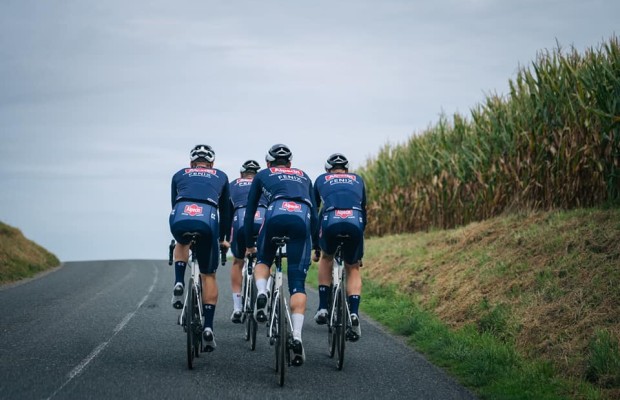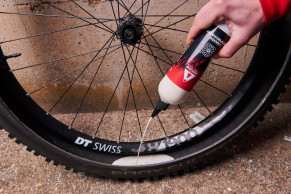What is rolling resistance and why are some tires faster than others?
Among all the forces that oppose the progress of the cyclist, rolling resistance is often the least considered. It is true that its influence, especially at high speeds, is less than, for example, aerodynamics but, after all, it is also a point where improvement can be sought to make it as minimal as possible and, therefore, save those precious watts that are never enough.

Everything you need to know to improve the rolling resistance of your wheels
If you have noticed the bikes of Soudal-QuickStep throughout this season, perhaps you have not paid attention to the detail but, in most races, their wheels have been fitted with Specialized Turbo Cotton tires, a model that can only be used with inner tubes. How can this be when tubeless is fully established in the peloton and generally rolls better?
The reason is that, in the tests carried out by the team, they achieved lower rolling resistance with the famous Turbo Cotton tires, one of the best tires ever made compared to the tubeless tires available in the Specialized range. Just a detail that indicates that, although for the majority of cyclists who hit the road it is a minor aspect, rolling resistance is taken into account by professionals at the same level as bike weight, transmission efficiency, or the trendy aerodynamics.
RECOMENDADO

What would you do if you won the lottery? This cyclist bought himself a €20,000 bike

The best exercise routine to do at home

Benefits of training in the cold

The cyclist's patience: how long, gentle training sessions build your best season

Tips for cycling in the rain

25 cycling gifts ideas to get it right

But, what is rolling resistance really? Very simple, one of the forces that opposes the progress of the cyclist. In this case, they are the losses that occur in the tire both due to its deformation when in contact with the road and due to the friction with the surface when rolling. Therefore, achieving the lowest possible rolling resistance will mean a power saving for the cyclist, that is, applying the same watts on the pedals will go faster in the same way that happens with more aerodynamic elements or with less weight when it comes to climbing.
Rolling resistance is determined by various factors: tire type, construction, tread, configuration, pressure, surface we ride on, or rubber compound. Let's analyze them one by one.
We start with the type of tire. Although tubeless is fully established nowadays, there are still many who use tires with inner tubes and, if we talk about road cycling or cyclocross, tubular tires also continue to have a certain presence. As a general rule, tubeless tires offer the best rolling resistance, mainly because they do not have an inner tube, an element that adds friction resulting in losses. However, this is a general rule that is not always fulfilled as we saw at the beginning in the case of Soudal-QuickStep.

With some tires, using latex tubes, or the modern TPU ones, it is possible to achieve a rolling resistance similar to that of tubeless. By the way, as we can see, the type of tube used also influences rolling resistance. In general, tubular tires also perform better in this aspect than tires with inner tubes due to the flexibility and geometry of their casing, although they have a small condition that affects how they are glued to the rim, so it is a process that must be done carefully to get the best performance out of them.
Then there is the tire construction and the compound used. Regarding the latter, manufacturers discovered years ago that by adding silicon to the rubber mixture of their tires, they could reduce rolling resistance, even some brands like Vittoria use graphene aiming for the same goal. In any case, other factors come into play here and brands are forced to find a delicate balance between the best rolling resistance, grip, and tire longevity.

The same happens with the casings where greater flexibility means better adaptation to the road and, therefore, better grip but, however, also greater deformation that adds rolling resistance so, again, a compromise must be reached so that the casing is solid enough to deform just enough.
And then we enter the parameters that any cyclist can play with to achieve the best rolling resistance. We are talking about the tire pressure and its width. In general, traditional road cyclists have tended to inflate their tires with excessive pressure under the false belief that this way they rolled better. Something that, although true on perfectly smooth roads, does not apply to most roads, with imperfections that cause the tire to constantly lose contact with the asphalt in an almost imperceptible way but that translates into wasted energy.
Today, the various tests that brands and teams carry out with tires have shown, on the one hand, that wider tires do not harm rolling resistance but can even improve it and, on the other hand, that lower pressure yields better results generally in rolling resistance. In fact, nowadays, riding in the professional peloton, the 700x28c size has become standard with some cyclists even using 30mm tires regularly. These tires are inflated to less than 5 bar of pressure, far from the 11 or 12 bar that were used years ago in 21mm tubular tires.

In disciplines like mountain biking, this is something that they discovered years ago and, today, even in cross country and marathon, they use tires with generous tread inflated at very low pressures, around 2 bar or less.
In any case, this is an aspect that depends on each cyclist since it is influenced, first of all, by their weight and then by the terrain where they are going to ride, if the asphalt is wet, and also personal preferences, so, in this point, there is no choice but to carry out our own tests until we find the best configuration.
We can check rolling resistance in various ways, but ultimately with methods similar to those used by brands to determine how to manufacture tires that roll better. A very easy way to test our tires is at home if we have a roller trainer. After pedaling for a few minutes to warm up both the tire and the roller and not affect the measurement, we will pedal at a certain wattage and, with a wheel magnet speedometer, we will see at what speed we are going. We will try different pressures until we find out at what pressure we go faster at a certain wattage.

This test can also be done on the road in a controlled place, where the wind does not affect us and we can pedal at a constant power. In fact, during the classics season, especially in a race as special as Paris-Roubaix, it is not uncommon to see professionals with a pressure gauge in the pocket of their jersey, riding the sections over and over again, varying pressures until they find the exact point with which they can ride more comfortably and with less rolling resistance. Every detail counts.